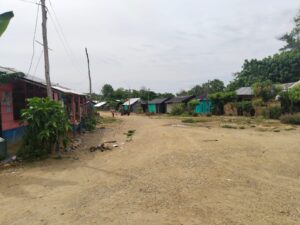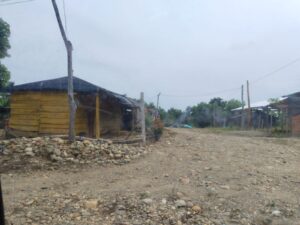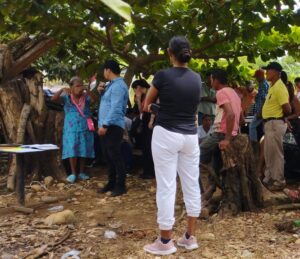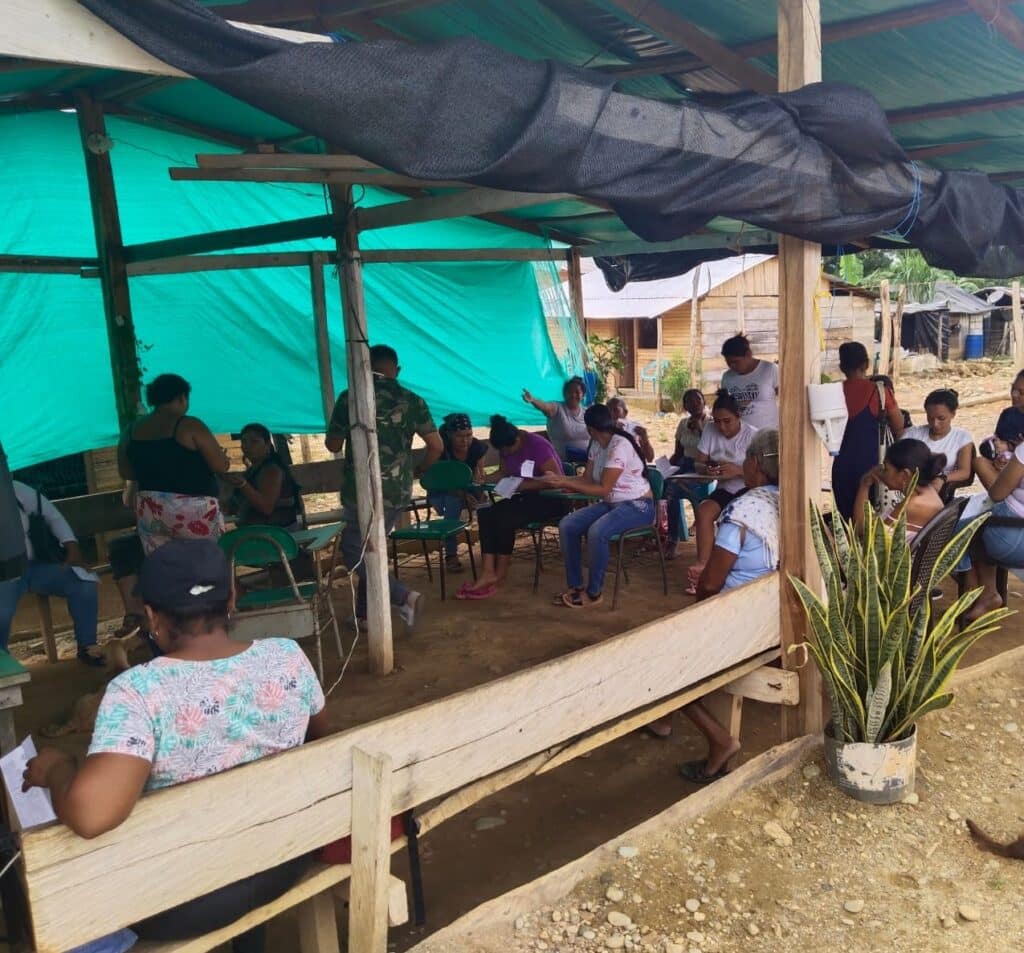Repairing Gaps, Repopulating Destroyed Places
Written by: Alex Maldonado-Lizardi and Xiomara Cintron-Garcia who serve with the Christian Centre for Justice, Peace and Nonviolent Action (Justapaz), Bogota, Colombia

“If you get rid of unfair practices,
quit blaming victims,
quit gossiping about other people’s sins,
If you are generous with the hungry
and start giving yourselves to the down-and-out,
Your lives will begin to glow in the darkness,
your shadowed lives will be bathed in sunlight.
I will always show you where to go.
I’ll give you a full life in the emptiest of places—
firm muscles, strong bones.
You’ll be like a well-watered garden,
a gurgling spring that never runs dry.
You’ll use the old rubble of past lives to build anew,
rebuild the foundations from out of your past.
You’ll be known as those who can fix anything,
restore old ruins, rebuild and renovate,
make the community livable again”.
–Isaiah 58, 11-12 (MSG)
There are territories where one would like to go, grab a megaphone and start shouting Isaiah 58, 11-12 for every sidewalk, for every house made of sticks from the Cauca River with mud and mining waste, for every field flattened by drones and bombs, for every settlement that is woven with displaced people from more than thirty regions of the country. One wishes so many times that fasts had that ancestral force that fixes the broken issues of life once and for all, but it is not so. Then, one sees pastors and social leaders walking through human settlements, and calling people to a meeting in the tent of the dirt plaza, and one knows that this force is still there, giving back the spirit to the people, enlivening the territory.
Every human settlement starts from a problematic legal premise: its illegality.
Article 2 of Law 2044 of 2020 lists two types of settlements with the same framework and the same illegitimacy:
1. Consolidated illegal human settlement
2. Precarious illegal human settlement
Their difference lies in the level of infrastructural development achieved by the settled communities: number of houses located, buildings, construction materials, infrastructure for public services installed, road paving and state institutions established and available, although none of this has functional urban planning principles.
Within this framework of habitability, on February 8, 2024, a team from Justapaz, together with church allies from the Jardín settlement, in Cáceres, Antioquia, strengthened a collaboration in accompaniment to define technical, legal and conceptual problems, towards a possible coordination of dialogues with national authorities and their respective responsibilities for monitoring and compliance with human rights in the territory.

The settlement is the result of years of violence and government negligence. In 2023 alone, “2,217 people were registered as victims of mass displacement events in the municipality of Cáceres,” says a report by the MIRE+ (Intersectoral Emergency Response Mechanism) in consortium with the organization Action Against Hunger. On July 9 of the same year, and with the regional elections on the sidelines, the Ombudsman’s Office denounced actions by illegal armed groups such as the Clan del Golfo, the Ejército de Liberación Nacional (ELN) and the FARC-EP dissidents who have forced peasants to demonstrate against the public force to prevent it from doing its constitutionally mandated work. They have also committed homicides, then preventing relatives from transporting the bodies to urban areas, forcing them to bury them in the fields to prevent the crime from being recorded.
There are numerous structural factors that condition and perpetuate these dynamics. The high rate of unemployment leads people to become involved in illegal mining, informal sales, and in more than one case, end up linked to armed groups for the benefits they offer such as surveillance, extortion, etc. And it seems that there is not much more when the civilian population is affected by the high costs of basic goods, the lack of local production in the gardens and in the raising of animals. Insufficient access to health and education also compounds this problem.
In February 2024, a note from Caracol Radio broadcast the complaint made by the leadership of the territory about how paramilitary groups had remodeled a health center in a village in Cáceres, supplanting the government’s responsibilities. At least that is what the headline stated.
On the other hand, a report by the organization Paz y Reconciliación, in 2018, stated that “one of the biggest problems for youth in Bajo Cauca, as in most of the country, is the lack of opportunities after finishing secondary and high school.” The aftermath is devastating: at least, some 500 young people who finish high school are left on a silver platter for armed actors, illegal economies and informality. They can join the logistics teams of these groups in messenger work; ‘bell-ringers’, who report to the different groups the entry of strange or foreign people into the territory; coca crop scrapers or “barequeros”[1] in some mine. Ultimately, some young people become involved as hitmen.
The settlements are becoming filled with the remains of these systemic components. For this reason, building peace there is not only about looking at imperatives of correct or moral conduct and legal frameworks, but also about setting the stage for formulating the continuity of life, through processes of social negotiation and minimum agendas of justice that lead to the gradual elaboration of collective, socio-cultural and political life projects, capable of framing a viable territorial coexistence where it would not seem so.
The tone of illegality given to these settlements fuels their constant stigmatization and marginalization, paralyzing the possibility of their restoration.
How can we reverse these patterns or change their composition into forms of solidarity that establish community autonomy, to repair gaps, repopulate devastated places (Is. 58,12)?
Every democratic sense has the diverse forms of the role of its citizens in it. This is made possible by the formation of civic consciences and social responsibility in each subject that makes up a community. From there, this awareness and responsibility must actively manage mechanisms for the protection of its democratic principles as “fundamental organizing” principles (such as Human Rights) that ensure respect for a dignified life and the differences between human beings.

This type of training exercise provides an ideal environment for the identification of conflicts originating in and from the community under a framework of transformation and reconciliation. After all, it is the communities who best understand their needs, sensitivities, activities and limitations, as well as the root points of their conflicts. This is a first step, reversing patterns of stigmatization and strengthening solidarity and community capacities for their own reconciliation.
It is only when local actors manage to resolve their differences at the community level and create a common sense of ownership and long-term sustainable responsibility that the gaps are repaired and what was devastated is repopulated. These are not strokes of luck. These are people mobilized by hope, guided by the God of life, satisfied in dry lands and rediscovering how to walk through them.
Reparar brechas, repoblar los lugares arrasados: acompañamiento al asentamiento, El Jardín, Cáceres, Antioquia
El Señor te guiará siempre;
te saciará en tierras resecas
y fortalecerá tus huesos.
Serás como jardín bien regado,
como manantial cuyas aguas no se agotan.
12 Tu pueblo reconstruirá las ruinas antiguas
y levantará los cimientos de antaño;
serás llamado “reparador de muros derruidos”,
“restaurador de calles transitables”.
-Isaías 58, 11-12 (NVI)
Hay territorios en los que uno quisiera bajarse, agarrar un megáfono y empezar a gritar Isaías 58, 11-12 por cada vereda, por cada casa hecha de palos del río Cauca con residuos de lodo y minería, por cada cancha aplastada por drones, por cada asentamiento que se teje con desplazados de más de treinta regiones del país. Uno quisiera tantas veces que los ayunos tuvieran esa fuerza ancestral y milenaria que arregla los asuntos desportillados de la vida de una vez, pero no es así. Entonces, uno ve pastores y líderes sociales caminando por los asentamientos humanos, y convocando gente a una reunión en la carpa de la plaza de tierra, y sabe que esa fuerza sigue ahí, devolviéndole el espíritu a la gente, animando el territorio.
Todo asentamiento humano parte de una premisa jurídica problemática: su ilegalidad.
En el artículo 2 de la Ley 2044 de 2020, se recogen dos tipos de asentamiento con el mismo marco y el mismo talante de ilegitimidad:
- Asentamiento humano ilegal consolidado
- Asentamiento humano ilegal precario[1]
Su diferencia descansa en el nivel de desarrollo infraestructural alcanzado por las comunidades asentadas: cantidad de viviendas ubicadas, edificaciones, materiales de construcción, infraestructura para servicios públicos instalada, pavimentación vial e institucionalidad estatal fijada y disponible, aunque nada de esto cuente con principios de planificación urbana funcionales.
En este marco de habitabilidad, durante el pasado 8 de febrero de 2024, un equipo de Justapaz, junto con aliados de iglesias del asentamiento Jardín, en Cáceres, Antioquia, fueron afianzando una colaboración en acompañamiento para definir problemáticas técnicas, jurídicas y conceptuales, hacia una posible coordinación de diálogos con autoridades nacionales y sus respectivas responsabilidades de veeduría y cumplimiento de DDHH en el territorio.
El asentamiento es resultado de años de dinámicas de violencia y negligencias gubernamental. Solo en 2023, “se registraron 2,217 personas como víctimas de eventos de desplazamiento masivo en el municipio de Cáceres”, dice un informe del MIRE+ (Mecanismo Intersectorial de Respuesta en Emergencia) en consorcio con la organización Acción Contra el Hambre.[2] El 9 de julio del mismo año, y con los comicios electorales regionales de costado, la Defensoría del Pueblo denunciaba acciones de grupos armados ilegales como el Clan del Golfo, el ELN y las disidencias de las FARC quienes
han obligado a campesinos a hacer manifestaciones contra la fuerza pública para impedirle ejercer su labor constitucional. También han implementado una modalidad de homicidio, en la que impiden a los familiares trasladar los cuerpos hasta las zonas urbanas, los obligan a enterrarlos en los campos para evitar que sea registrado el hecho criminal[3].
Son numerosos los factores estructurales que condicionan y perpetúan estas dinámicas. La baja tasa de empleo lleva a que personas se vinculen a la minería ilegal, las ventas informales y, en más de un caso, acaben vinculadas a grupos armados por los beneficios que ofrecen en el territorio a través de servicios como vigilancia, extorsión, etc. Y es que no parecería haber mucho más cuando la población civil se ve afectada por los altos costos de la canasta familiar, la falta de producción local en las huertas y en la crianza de animales. A esto suman los insuficientes accesos a la salud y educación.
En febrero de 2024, una nota de Caracol Radio difundía la denuncia que hiciera el liderazgo del territorio sobre cómo las AGC habrían remodelado un centro de salud en una vereda en Cáceres suplantando las responsabilidades y funciones correspondientes al Estado. Al menos eso señalaba el titular.
Por otro lado, un diagnóstico para un reportaje de la organización Paz y Reconciliación, se planteaba en 2018 que “uno de los mayores problemas para la juventud en el Bajo Cauca, como en la mayoría del país, es la falta de oportunidades después de finalizar la educación media y secundaria”. La secuela es desoladora:
como mínimo, unos 500 jóvenes que terminan su bachillerato quedan en bandeja de plata para los actores armados, las economías ilegales y la informalidad. Estos pueden entrar a equipos de logística de estos grupos en labores de mensajería; ‘campaneros’, que reportan a los distintos grupos la entrada de personas extrañas o ajenas al territorio; raspadores de cultivos de coca o barequeros[4] en alguna mina. En últimas, algunos jóvenes llegan a vincularse como sicarios[5].
Los asentamientos se van llenando de los saldos de esos componentes sistémicos. Por esto, en ellos, construir paz no solo es mirar imperativos de conducta y marcos jurídicos, sino plantear el ámbito para formular la continuidad de la vida, a través de procesos de negociación social y agendas mínimas de justicia que deriven en la elaboración paulatina de proyectos de vida colectivos, socio-culturales y políticos, capaces de enmarcar una convivencia territorial viable donde no lo parecería.
El tono de ilegalidad otorgado a estos asentamientos abastece su constante estigmatización y marginalidad, embargando la posibilidad de su restauración.
¿Cómo invertir estos patrones o trocar su composición hacia formas solidarias y que asienten las autonomías comunitarias, para reparar brechas, repoblar los lugares arrasados (Is. 58,12)?
Todo sentido democrático cuenta con las formas diversas del papel de su ciudadanía en ella. Esto se viabiliza con la formación de conciencias cívicas y de responsabilidad social en cada sujeto que conforma una comunidad. Desde allí, esa conciencia y responsabilidad debe gestionar, de forma activa, mecanismos para la protección de sus principios democráticos en cuanto principios “organizadores fundamentales” (como los Derechos Humanos) que velan por el respeto a la vida digna y las diferencias entre los seres humanos[6].
Este tipo de ejercicio formativo surte un ámbito idóneo para la identificación de los conflictos originados en y desde la comunidad bajo un marco de transformación y reconciliación. Después de todo, son las comunidades quienes mejor comprenden sus necesidades, sensibilidades, actividades y limitaciones, así como los puntos de raíz de sus conflictos. Este es un primer paso, invertir patrones de estigmatización y afianzar las capacidades solidarias y comunitarias para su propia reconciliación[7].
Y es que es solo cuando los actores locales logran resolver sus diferencias a nivel comunitario, y conforman un sentido común de propiedad y responsabilidad sostenible a largo plazo que las brechas se reparan y lo arrasado se vuelve a poblar. No son golpes de suerte. Son pueblos movilizados por la esperanza, guiados por el Dios de la vida, saciados en tierras resecas y redescubriendo cómo caminar sobre ellas.
Alex and Xiomara’s appointments are made possible by your gifts to Disciples Mission Fund, Our Church’s Wider Mission, and your special gifts.
Make a gift that supports the work of Alex Maldonado-Lizardi and Xiomara Cintron-Garcia
[1] LEY N° 2044 30 de julio de 2020 “POR EL CUAL SE DICTAN NORMAS PARA EL SANEAMIENTO DE PREDIOS OCUPADOS POR ASENTAMIENTOS HUMANOS ILEGALES Y SE DICTAN OTRAS DISPOSICIONES”, Minvivienda, aceeso el 14 de agosto de 2024, https://minvivienda.gov.co/sites/default/files/normativa/ley-2044-del-30-de-julio-de-2020_0.pdf
[2] «Colombia: Ficha de Cierre de Emergencias – Antioquia, Cáceres – MIRE+ (04/12/2023)», Reliefweb, acceso el 14 de agosto de 2024, https://reliefweb.int/report/colombia/colombia-ficha-de-cierre-de-emergencias-antioquia-caceres-mire-04122023#:~:text=En%20el%20a%C3%B1o%202023%2C%20se,por%20eventos%20de%20desplazamiento%20masivo.
[3] «Defensoría del Pueblo solicita a grupos armados no instrumentalizar a población de Cáceres (Antioquia) en su disputa territorial», Defensoría del Pueblo, acceso el 14 de agosto de 2024, https://www.defensoria.gov.co/-/defensor%C3%ADa-del-pueblo-solicita-a-grupos-armados-no-instrumentalizar-a-poblaci%C3%B3n-de-c%C3%A1ceres-antioquia-en-su-disputa-territorial
[4] Técnica tradicional o ancestral para la minería en río con la que se obtiene el oro con herramientas manuales en el lecho y playas del río Cauca y sus afluentes. (https://www.responsiblemines.org/2019/04/el-barequeo-en-colombia-un-patrimonio-cultural-incomodo-2/)
[5] Sebastián Mora, «Una apuesta por la juventud en el Bajo Cauca», Fundación Paz y Reconciliación, 18 de octubre de 2018, acceso el 14 de agosto de 2023, Una apuesta por la juventud en el Bajo Cauca (pares.com.co)
[6] Cuestas, 210.
[7] Justapaz, Acción pública… 2019.
[1] Traditional or ancestral technique for river mining in which gold is obtained with manual tools in the bed and beaches of the Cauca River and its tributaries. (https://www.responsiblemines.org/2019/04/el-barequeo-en-colombia-un-patrimonio-cultural-incomodo-2/)

